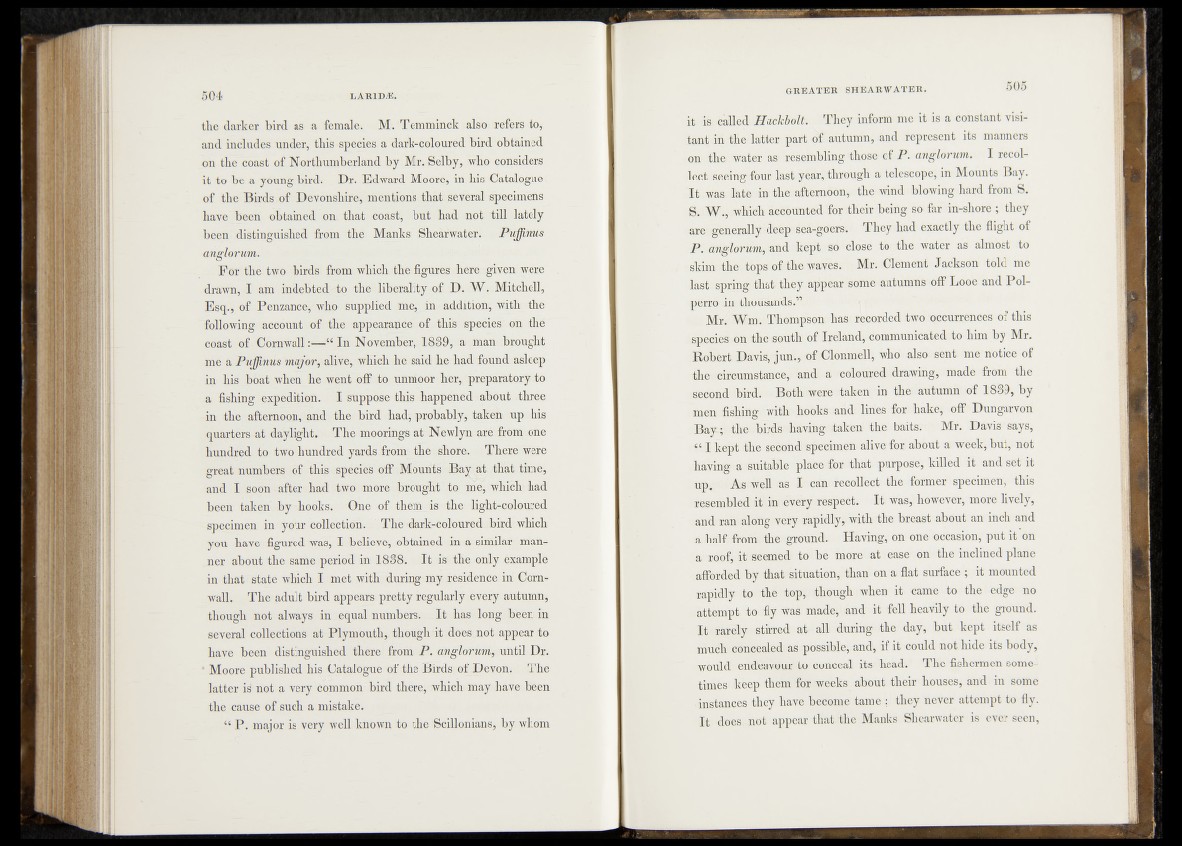
the darker bird as a female. M. Temminck also refers to,
and includes under, this species a dark-coloured bird obtained
on the coast of Northumberland by Mr. Selby, who considers
it to be a young bird. Dr.-Edward Moore, in his Catalogue ,
of the Birds of Devonshire, mentions that several specimens
have been obtained on. that coast, but had not till lately
been distinguished from the Manks Shearwater. Pujfinus
anglorum.
For the two birds from which the figures here given were
drawn, I am indebted to the liberality of D. W. Mitchell,
Esq., of Penzance, who supplied me, in addition, with the
following account of the appearance of this species' on the
coast of Cornwall:—“ In November, 1839, a man brought
me a Pujfinus major, alive, which he said he had found asleep
in his boat when he went off to unmoor her, preparatory to
a fishing expedition. I "Suppose this happened about .three
in the afternoon, and the bird had, probably, taken up his
quarters at daylight. The moorings at Newlyn are from one
hundred to two hundred yards from the shore. There were
great numbers of this species off Mounts Bay at that time,
and I soon - after had two more brought to me', which' had
been taken by-hooks. One of them is the light-coloured
specimen in your collection. The dark-coloured bird which
you have figured was, I believe^ obtained in a similar manner
about the same period in 1838. It is- the only example
in that state which I met with during my residence: in Cornwall.
The adult bird appears pretty regularly every autumn,
though not always in equal numbers. I t has long been in
several collections at Plymouth, though ‘it’ does „not appear to
have been distinguished there from P. anglorum, until Dr.
* Moore published his Catalogue of the Birds of Devon. The
latter is not a very common bird there, which may have been
the cause of such a mistake.
“ P . major is very well known to the Scillonians, by whom
it is called Hackbolt. They inform me it is a constant visitant
in the latter part of autumn, and represent its manners
on the water as resembling those of P . anglorum. I recollect
seeing four last year, through a telescope, in Mounts Bay.
I t was late in the afternoon, the wind blowing hard from S.
S. W., which accounted for their being so far in-shore ; they
are generally deep sea-goers. They had exactly the flight of
P. anglorum, and kept so close to the water as almost to
skim the. tbps of the waves. Mr. Clement Jackson told me
last spring that- they appear some autumns off Looe and Pol-
perro in thousands.11.;
Mr. Wm. ^Thompson; has recorded two occurrences of this
species on the south of Ireland, communicated to him by Mr.
Robert Davis, jun., of Clonmell, who also sent me notice of
the circumstance^and a coloured drawing, made from the
second bird. Both were taken’’' in the autumn of 1839, by
men fishing with hooks and lines for hake, off Dungarvon
Bayip.tlre birds having taken the baits. Mr. Davis says,
“ I kept the second specimen alive for, about a week, but, not
having a suitable place for that purpose, killed it and set it
up. As well ;as I can recollect the former specimen, this
resembled it in every respect. I t was, however, more lively,
and ran along very rapidly, with the breast about an inch and
a half from the ground. Having, on one occasion, put it on
a roof, it seemed to be more at ease on the inclined plane
afforded by that situation, than on a flat surface ; it mounted
rapidly to the top, though when it came to the edge no
attempt to fly was made, and it fell heavily to the ground.
It rarely stirred at all during the day, but kept itself as
much concealed as possible, and, if it could not hide its body,
would endeavour to conceal its head. The fishermen sometim
e keep them for weeks about their houses, and in some
instances they have become tame ; they never attempt to fly.
I t does not appear that the Manks Shearwater is ever seen,